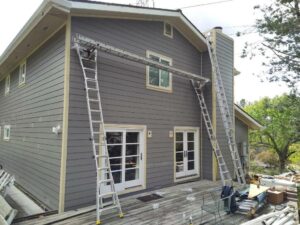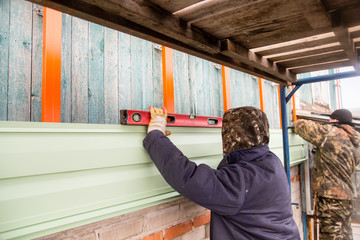Recognizing When Your Home Needs a Siding Repair
While vinyl siding is durable, wear and tear damage can still happen. It’s important to recognize when a repair or replacement is needed.

Often, a small hole or crack can be repaired quickly and inexpensively. For example, filling a hole in vinyl siding can be as simple as cleaning the area and then applying a caulk. However, if you need help from experts, contact Charleston Advanced Siding Repair now!
Your siding provides insulation to help keep your home warm or cool as needed. If it’s damaged or missing, your HVAC system will have to work harder to keep the house comfortable. That increased work can lead to higher energy bills over time.
Fortunately, there are several signs you should look out for to know when it’s time to repair or replace your siding. For instance, if you notice any peeling paint or loose wallpaper inside the house, it may indicate that moisture is seeping underneath the siding and percolating through to your wallboards. Moisture in your walls can cause a host of problems, including wood damage, rotting and mold growth.
Another sign that it’s time for a siding replacement is if you notice any cracking or splitting of the siding. Even though these signs might seem minor, they can quickly lead to more extensive problems and increase the cost of repairing or replacing your siding.
Other warning signs include any fungus, mildew or mold growth on your siding. Fungus, mildew and mold can indicate that moisture is penetrating the siding and causing unwelcome growth or structural damage to your home. Mold can also pose a health risk for you and your family, causing respiratory issues and allergic reactions.
After a bad storm, it’s important to assess and repair your siding as soon as possible. This is especially true during temperamental seasons, as a follow up storm that hits before repairs are made can exponentially worsen the damage.
When a section of your siding is damaged, it’s a good idea to replace it with an identical piece. You can usually find additional siding around your home or at a home improvement store. When installing the new piece of vinyl siding, remember to leave a little extra siding on each side of the panel. This will allow you to remove the top nailing strip and apply construction adhesive later. After the adhesive is dry, you can trim the excess siding to make sure it’s even with the rest of your home. This will prevent water from seeping into your walls and causing more unwelcome damage.
Damaged or missing siding can increase your energy bills.
Siding is supposed to protect your home’s foundation, structural integrity, and family members from the elements. But siding isn’t indestructible and it’s important to keep an eye out for signs of damage that could lead to costly repairs or replacement down the road.
Gaps or holes in your siding can be a serious problem, especially when it comes to your home’s energy efficiency. They allow cool or warm air to escape your home, which means that you have to use more power to keep it at a comfortable temperature.
Small gaps can be repaired with caulk, which is a mixture of latex and acrylic materials that is meant to seal small gaps in your siding. It’s best to only use caulk on gaps that are less than a quarter-inch wide. Anything larger may be too big for a simple caulking job, so it’s better to replace the affected siding panels with new ones.
If you notice that one section of your siding is missing or damaged, you should hire a professional to replace it as soon as possible. This way, the rest of your siding can stay intact and a gap is not left that can cause more damage in the future.
Another sign to look for is wood rot or mold on the inside of your siding. When these issues begin to appear, they can lead to water leaking behind your siding and into your home’s walls. This can cause major damage to your wallboard and even lead to an odor in your home.
When you see dents in your siding, it’s likely due to the severity of a recent storm. The dents are caused when wind speeds reach a certain level, and debris from your yard is picked up and thrown against your house. It’s best to have dents fixed by a professional as soon as you notice them.
The longer you wait to get your siding repaired, the worse it will become and the more expensive the repair or replacement will be. It’s a good idea to take some time to inspect your siding, and if you spot any damage, be sure to call a professional to repair it as soon as possible.
Damaged or missing siding can affect your home’s appearance.
Aside from being unattractive, missing and damaged siding can also leave your home vulnerable to damage from the elements. Without the protection of a solid outer shell, your home can be exposed to water infiltration and pest infestation. If you notice that one of your home’s panels is cracked, dented, or missing altogether, it’s time to call a siding contractor in your area.
A common cause of these types of issues is a storm, but it’s not just rain, wind, and changing temperatures that can affect your siding’s quality. Over time, sun exposure can cause vinyl and fiberglass siding to become brittle, while wood can experience rot or insect infestations.
Missing and damaged siding leaves your house exposed to all of these things, and can also lead to other problems. For instance, if your siding has holes in it, moisture will seep into your home, causing warping and other structural damage. If the problem is left unchecked, it can lead to dry rot and mold growth that can affect your entire home’s interior.
Another common issue caused by missing or damaged siding is the fact that other portions of your home will begin to fall off or get damaged. When your siding is intact, it locks together to support and protect the other sections of your house. Without this protection, other portions of your house will slowly wear away over time, and can eventually fall off completely.
Finally, missing or damaged siding can make your home look shabby and unkempt. This can hurt its curb appeal and can also decrease your home’s value if you decide to sell it in the future.
If you have noticed signs of damage to your siding, it’s important to act fast. By working with a professional, you can quickly and efficiently repair any existing issues and ensure that your siding is in good condition for years to come. By acting early, you can prevent expensive repairs and potential structural damage in the future. Contact your local siding contractor today to schedule an inspection. They can help you determine whether your siding needs to be repaired or replaced, and recommend the best course of action for your unique situation.
Damaged or missing siding can affect your home’s value.
Many homeowners think of their siding as invincible, but the truth is that it can be damaged by a variety of factors. This includes extreme weather, poor installation, and pest infestations. If your siding is in need of repairs, it can negatively impact your home’s value.
A common sign that your siding is in need of repair is rot. This is a serious issue that can cause significant damage to your home’s frame. If you notice rotting, you should have it inspected by a professional to determine the extent of the damage and what needs to be done.
Another important sign that your siding is in need of repair or replacement is swelling. This is caused by water that has built up inside the wall. Over time, this can cause the siding to swell and may even cause it to crack or break. This is a sign that there is a problem with the framing underneath the siding, which will need to be repaired or replaced by a carpenter.
If you’re planning on selling your home in the near future, it’s a good idea to repair or replace any parts of your siding that are damaged or showing signs of wear and tear. This will help ensure that your home is in good condition for potential buyers, and it’ll also make the process of selling your home go much more smoothly.
Besides being an eyesore, cracked or missing siding can provide an easy entry point for insects and other unwanted guests. These unwelcome visitors will be drawn to holes or cracks in your siding, which can lead to serious damage to the structure of your house.
In some cases, large sections of siding will need to be completely removed and replaced. This is usually the case when the siding has been badly affected by weather or when there is a bad case of mildew or rot that cannot be treated. Replacing your siding will typically cost more than repairing it, as you will need to buy new materials and possibly paint them as well.

